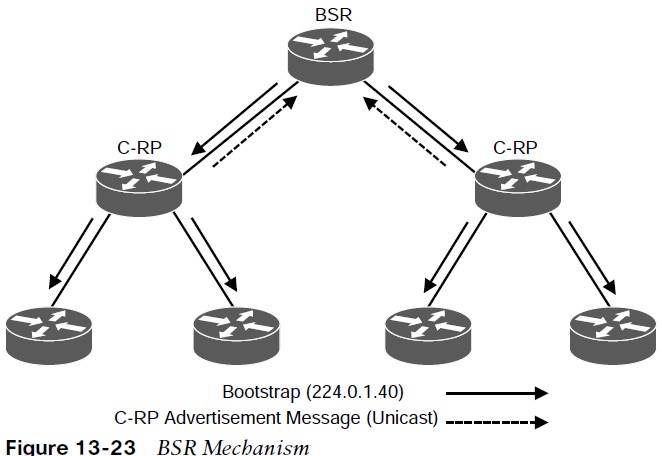
Rendezvous Points
the purpose, function, and operation of rendezvous points in a multicast network.
- In PIM-SM, it is mandatory to choose one or more routers to operate as RPs. An RP is a single common root placed at a chosen point of a shared distribution tree.
- An RP can be either configured statically in each router or learned through a dynamic mechanism.
- A PIM router can be configured to function as an RP either statically in each router in the multicast domain or dynamically by configuring Auto-RP or a PIM bootstrap router (BSR).
Static RP
- It is possible to statically configure RP for a multicast group range by configuring the address of the RP on every router in the multicast domain.
- Configuring static RPs is relatively simple and can be achieved with one or two lines of configuration on each router.
- If the network does not have many different RPs defined or if the RPs do not change very often, this could be the simplest method for defining RPs.
- However, static configuration can increase administrative overhead in a large and complex network. Every router must have the same RP address. Changing the RP address requires reconfiguring every router. If several RPs are active for different groups, information about which RP is handling which multicast group must be known by all routers. To ensure this information is complete, multiple configuration commands may be required.
- If a manually configured RP fails, there is no failover procedure for another router to take over the function performed by the failed RP, and this method by itself does not provide any kind of load splitting.
Auto- RP
Auto-RP is a Cisco proprietary mechanism that automates the distribution of group-toRP mappings in a PIM network. Auto-RP has the following benefits:
- It is easy to use multiple RPs within a network to serve different group ranges.
- It allows load splitting among different RPs.
- It simplifies RP placement according to the locations of group participants.
- It prevents inconsistent manual static RP configurations that might cause connectivity problems.
- Multiple RPs can be used to serve different group ranges or to serve as backups for each other.
- The Auto-RP mechanism operates using two basic components, candidate RPs (CRPs) and RP mapping agents (MAs).
Candidate RPs and RP Mapping Agents
- A C-RP advertises its willingness to be an RP via RP announcement messages to 224.0.1.39 (Cisco-RP-Announce).
- The RP announcements contain the default group range 224.0.0.0/4, the C-RP’s address, and the hold time, which is three times the RP announce interval.
- If there are multiple C-RPs, the C-RP with the highest IP address preferred.
- RP MAs join group 224.0.1.39 to receive the RP announcements. They store the information contained in the announcements in a group-to-RP mapping cache, along with hold times. If multiple RPs advertise the same group range, the C-RP with the highest IP address is elected.
- The RP MAs advertise the RP mappings to another well-known multicast group address, 224.0.1.40 (Cisco-RP-Discovery). These messages advertised by default every 60s or when changes detected. The MA announcements contain the elected RPs and the group-to-RP mappings. All PIM-enabled routers join 224.0.1.40 and store the RP mappings in their private cache.
PIM Bootstrap Router
The BSR router mechanism, RFC 5059, mechanism that provides a fault-tolerant, automated RP discovery and distribution mechanism. PIM uses the BSR to discover and announce RP set information for each group prefix to all the routers in a PIM domain. This is the same function accomplished by Auto-RP, but the BSR is part of the PIM Ver2 specification. The RP set is a group-to-RP mapping that contains the following components:
- Multicast group range
- RP priority
- RP address
- Hash mask length
- SM/Bidir flag
Candidate RPs
 Figure 13-23 illustrates the BSR mechanism, where the elected BSR receives candidate RP advertisement messages from all candidate RPs in the domain, and it then sends BSR messages with RP set information out all PIM-enabled interfaces, which are flooded hop-by-hop to all routers in the network.
Figure 13-23 illustrates the BSR mechanism, where the elected BSR receives candidate RP advertisement messages from all candidate RPs in the domain, and it then sends BSR messages with RP set information out all PIM-enabled interfaces, which are flooded hop-by-hop to all routers in the network.
- The active BSR stores all incoming C-RP advertisements in its group-to-RP mapping cache.
- BSR then sends the entire list of C-RPs from its group-to-RP mapping cache in BSR messages every 60 seconds by default to all PIM routers in the entire network.
- As the routers receive copies of these BSR messages, they update the information in their local group-to-RP mapping caches, and this allows them to have full visibility into the IP addresses of all C-RPs in the network.
Other useful information: